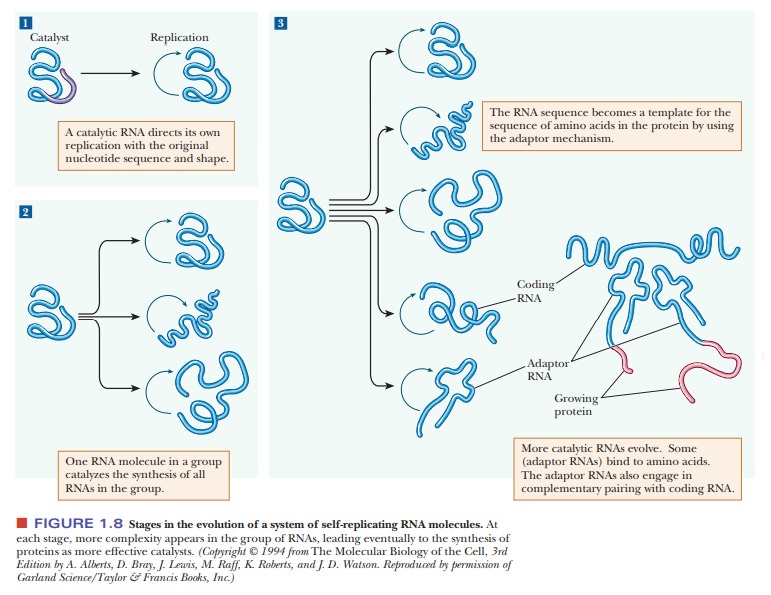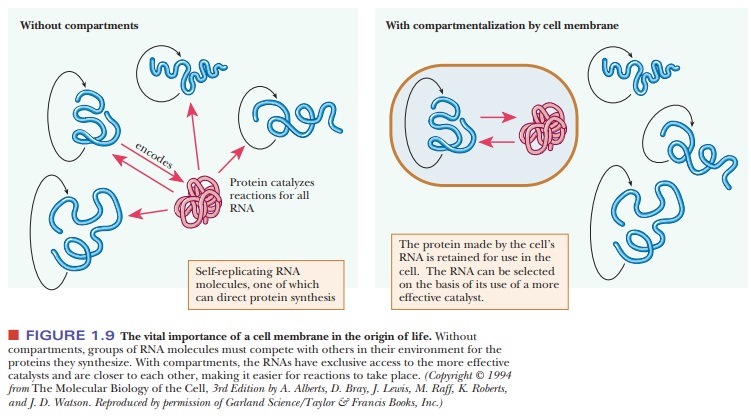Chapter: Biochemistry: Biochemistry and the Organization of Cells
Molecules to Cells: Which came first - the catalysts or the hereditary molecules?
Molecules to Cells
Which came first-the catalysts or
the hereditary molecules?
A discovery with profound implications for discussions of the origin of life is that RNA (ribonucleic acid), another nucleic acid, is capable of catalyzing its own processing. Until this discovery, catalytic activity was associated exclusively with proteins. RNA, rather than DNA, is now considered by many scientists to have been the original coding material, and it still serves this function in some viruses. The idea that catalysis and coding both occur in one molecule has provided a point of departure for more research on the origins of life.
The “RNA world”
is the current conventional wisdom, but many unanswered questions exist
regarding this point of view.
According
to the RNA-world theory, the appearance of a form of RNA capable of coding for
its own replication was the pivotal point in the origin of life.
Polynucleotides can direct the formation of molecules whose sequence is an
exact copy of the original. This process depends on a template mechanism
(Figure 1.7), which is highly effective in producing exact copies but is a
rela-tively slow process. A catalyst is required, which can be a
polynucleotide, even the original molecule itself. Polypeptides, however, are
more efficient catalysts than polynucleotides, but there is still the question
of whether they can direct the formation of exact copies of themselves. Recall
that in present-day cells, the genetic code is based on nucleic acids, and
catalysis relies primarily on pro-teins. How did nucleic acid synthesis (which
requires many protein enzymes) and protein synthesis (which requires the
genetic code to specify the order of amino acids) come to be? According to this
hypothesis, RNA (or a system of related kinds of RNA) originally played both
roles, catalyzing and encoding its own replication. Eventually, the system
evolved to the point of being able to encode the synthesis of more effective
catalysts, namely proteins (Figure 1.8). Even later, DNA took over as the
primary genetic material, relegating the more versatile RNA to an intermediary
role in directing the synthesis of proteins under the direction of the genetic
code residing in DNA. A certain amount of controversy surrounds this theory,
but it has attracted considerable attention recently. Many unanswered questions
remain about the role of RNA in the origin of life, but clearly that role must
be important.


Another
key point in the development of living cells is the formation of membranes that
separate cells from their environment. The clustering of cod-ing and catalytic
molecules in a separate compartment brings molecules into closer contact with
each other and excludes extraneous material. For reasons we shall explore,
lipids are perfectly suited to form cell membranes (Figure 1.9). For a
particularly good summary of this scenario. This article was the grand-prize
winner in an essay contest for young scientists.

Some theories on the origin of life focus on the importance of proteins in the development of the first cells. A strong piece of experimental evidence for the importance of proteins is that amino acids form readily under abiotic conditions, whereas nucleotides do so with great difficulty. Proteinoids are artificially synthesized polymers of amino acids, and their properties can be compared with those of true proteins. Although some evidence exists that the order of amino acids in artificially synthesized proteinoids is not com-pletely random-a certain order is preferred-there is no definite amino acid sequence. In contrast, a well-established, unique amino acid sequence exists for eachprotein produced by present-day cells. According to the theory that gives primaryimportance to proteins, aggregates of proteinoids formed on the early Earth, probably in the oceans or at their edges. These aggregates took up other abioti-cally produced precursors of biomolecules to become protocells, the precursors of true cells. Several researchers have devised model systems for protocells. In one model, artificially synthesized proteinoids are induced to aggregate, forming structures called microspheres. Proteinoid microspheres are spherical in shape, as the name implies, and in a given sample they are approximately uni-form in diameter. Such microspheres are certainly not cells, but they provide a model for protocells. Microspheres prepared from proteinoids with catalytic activity exhibit the same catalytic activity as the proteinoids. Furthermore, it is possible to construct such aggregates with more than one type of catalytic activity as a model for primitive cells.
Note that these aggregates lack a coding
system. Self-replication of peptides (coding and catalysis carried out by the
same molecule) has been reported, but that work was done on isolated peptides,
not on aggregates.
Recently,
attempts have been made to combine several lines of reasoning about the origin
of life into a double-origin theory.
According to this line of thought, the development of catalysis and the development
of a coding system came about separately, and the combination of the two
produced life as we know it. The rise of aggregates of molecules capable of
catalyzing reactions was one origin of life, and the rise of a nucleic
acid-based coding system was another origin.
A theory
that life began on clay particles is a form of the double-origin theory.
According
to this point of view, coding arose first, but the coding material was the
surface of naturally occurring clay. The pattern of ions on the clay sur-face
is thought to have served as the code and the process of crystal growth is
thought to have been responsible for replication. Simple molecules, and then
protein enzymes, arose on the clay surface, eventually giving rise to
aggregates that provided the essential feature of compartmentalization. At some
later date, the rise of RNA provided a far more efficient coding system than
clay, and RNA-based cells replaced clay-based cells. This scenario assumes that
time is not a limiting factor in the process.
At this
writing, none of the theories of the origin of life is definitely estab-lished,
and none is definitely disproved. The topic is still under active
investi-gation. It seems highly unlikely that we will ever know with certainty
how life originated on this planet, but these conjectures allow us to ask some
of the important questions, such as those about catalysis and coding, that we
are going to see many times in this text.
Summary
Our solar system, including
the Earth, is postulated to have been formed from chemical elements produced by
first-generation stars. The early Earth had an atmosphere that consisted of
simple chemical compounds.
The atmospheric conditions of the early Earth
allowed the formation of molecules, such as amino acids, that play a role in
life processes.
Several
theories describe the origin of living cells from component mol-ecules. All
require explanations for coding and for catalytic activity, and all assign an
important role to RNA.
Related Topics